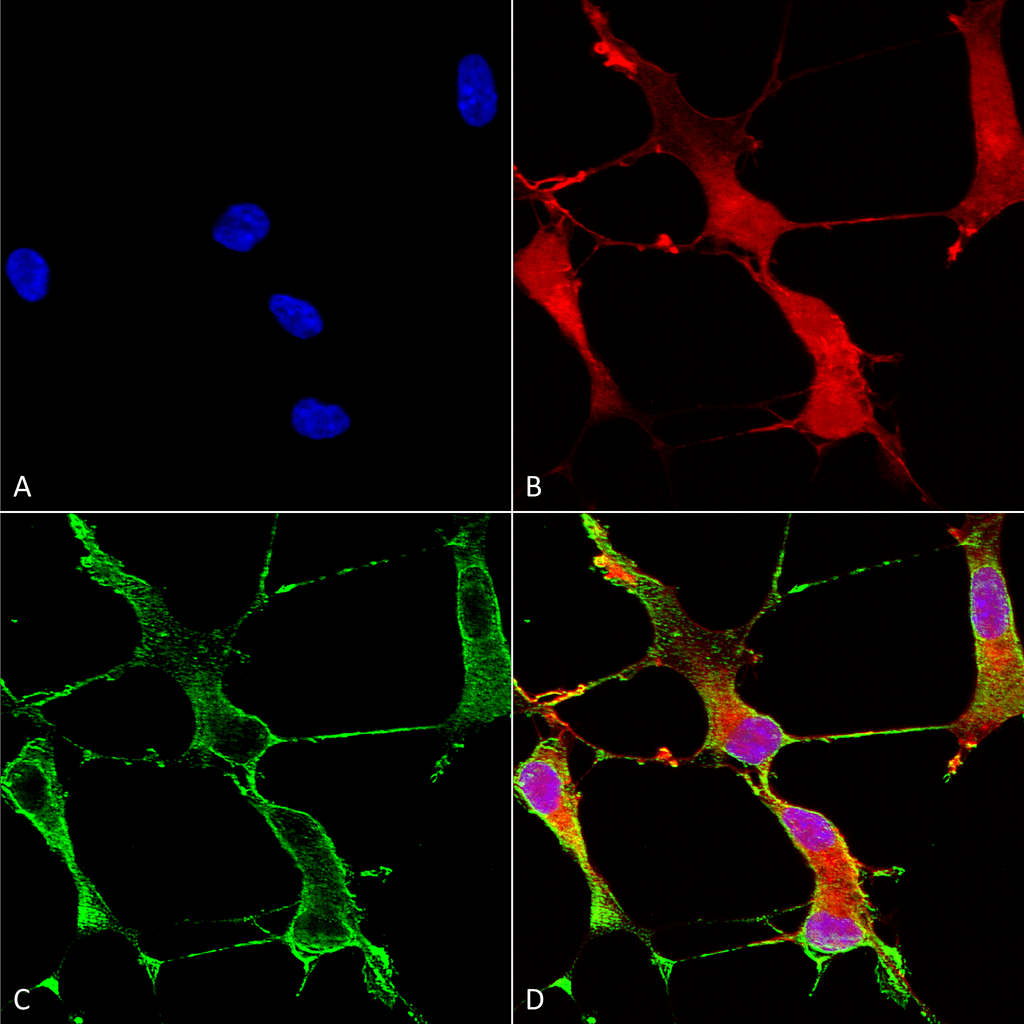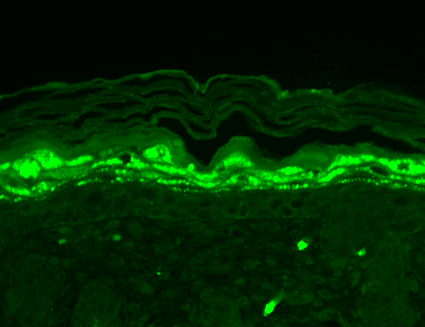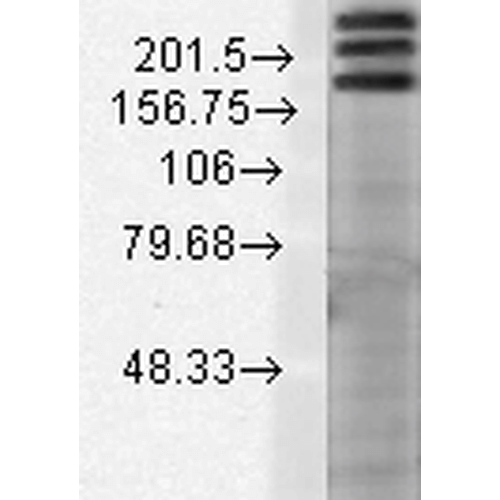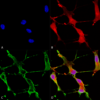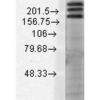Anti-Shank 1 Antibody (56469)
$466.00
SKU: 56469
Categories: Antibody Products, Neuroscience and Signal Transduction Antibodies, Products
Overview
Product Name Anti-Shank 1 Antibody (56469)
Description Anti-Shank1 Mouse Monoclonal Antibody
Target Shank 1
Species Reactivity Human, Mouse, Rat
Applications WB,IHC,AM
Host Mouse
Clonality Monoclonal
Clone ID S22-21
Isotype IgG1
Immunogen Fusion protein corresponding to aa 469-691 (SH3/PDZ domains) of rat Shank1 (accession no. Q9WV48). This sequence is 96
Properties
Form Liquid
Concentration Lot Specific
Formulation PBS, pH 7.4; 50% glycerol, 0.09% sodium azide.
Buffer Formulation Phosphate Buffered Saline
Buffer pH pH 7.4
Buffer Anti-Microbial 0.09% Sodium Azide
Buffer Cryopreservative 50% Glycerol
Format Purified
Purification Purified by Protein G affinity chromatography
Specificity Information
Specificity This antibody recognizes human, mouse, and rat Shank 1. It does not react with Shank2 or 3.
Target Name SH3 and multiple ankyrin repeat domains protein 1
Target ID Shank 1
Uniprot ID Q9WV48
Alternative Names Shank1, GKAP/SAPAP-interacting protein, SPANK-1, Somatostatin receptor-interacting protein, SSTR-interacting protein, SSTRIP, Synamon
Gene Name Shank1
Sequence Location Cytoplasm, Cell junction, synapse, Cell junction, synapse, postsynaptic density
Biological Function Seems to be an adapter protein in the postsynaptic density (PSD) of excitatory synapses that interconnects receptors of the postsynaptic membrane including NMDA-type and metabotropic glutamate receptors, and the actin-based cytoskeleton. Plays a role in the structural and functional organization of the dendritic spine and synaptic junction. Overexpression promotes maturation of dendritic spines and the enlargement of spine heads via its ability to recruit Homer to postsynaptic sites, and enhances presynaptic function. {PubMed:11498055, PubMed:18287537}.
Research Areas Neuroscience
Background Shank proteins are a family of scaffold proteins identified through their interaction with a variety of membrane and cyto- plasmic proteins. Shank proteins at postsynaptic sites of excitatory synapses play roles in signal transmission into the postsynaptic neuron. Shank proteins are crucial in receptor tyrosine kinase signaling. Recent studies suggest that disruption of glutamate receptors at the Shank-postsynaptic platform could contribute to the destruction of post- synaptic density which underlies synaptic dysfunction and loss in Alzheimer's disease. Shank1 might be relevant to human autism spectrum disorders due to its differential role in specific cognitive processes along with its importance in synapse structure and function.
Application Images




Description Immunocytochemistry/Immunofluorescence analysis using Mouse Anti-SHANK1 Monoclonal Antibody, Clone S22-21 (56469). Tissue: Neuroblastoma cells (SH-SY5Y). Species: Human. Fixation: 4% PFA for 15 min. Primary Antibody: Mouse Anti-SHANK1 Monoclonal Antibody (56469) at 1:50 for overnight at 4°C with slow rocking. Secondary Antibody: AlexaFluor 488 at 1:1000 for 1 hour at RT. Counterstain: Phalloidin-iFluor 647 (red) F-Actin stain; Hoechst (blue) nuclear stain at 1:800, 1.6mM for 20 min at RT. (A) Hoechst (blue) nuclear stain. (B) Phalloidin-iFluor 647 (red) F-Actin stain. (C) SHANK1 Antibody (D) Composite.

Description Immunohistochemistry analysis using Mouse Anti-SHANK1 Monoclonal Antibody, Clone S22-21 (56469). Tissue: backskin. Species: Mouse. Fixation: Bouin's Fixative and paraffin-embedded. Primary Antibody: Mouse Anti-SHANK1 Monoclonal Antibody (56469) at 1:100 for 1 hour at RT. Secondary Antibody: FITC Goat Anti-Mouse (green) at 1:50 for 1 hour at RT. Localization: Filaggrin-like staining (upper layer aggregations of staining).

Description Western Blot analysis of Rat brain membrane lysate showing detection of SHANK1 protein using Mouse Anti-SHANK1 Monoclonal Antibody, Clone S22-21 (56469). Load: 15 µg. Block: 1.5% BSA for 30 minutes at RT. Primary Antibody: Mouse Anti-SHANK1 Monoclonal Antibody (56469) at 1:1000 for 2 hours at RT. Secondary Antibody: Sheep Anti-Mouse IgG: HRP for 1 hour at RT.
Handling
Storage This antibody is stable for at least one (1) year at -20°C.
Dilution Instructions Dilute in PBS or medium that is identical to that used in the assay system.
Application Instructions Immunoblotting: use at 1-10ug/mL. Bands of ~190-220kDa (alternative splice variants) are detected.Immunohistochemistry and
Immunocytochemistry: use at 0.1-1ug/mL
Immunofluorescence: use at 1-10ug/mL
These are recommended concentrations. User should determine optimal concentrations for their application.
Positive control: Adult rat brain.
Immunocytochemistry: use at 0.1-1ug/mL
Immunofluorescence: use at 1-10ug/mL
These are recommended concentrations. User should determine optimal concentrations for their application.
Positive control: Adult rat brain.
References & Data Sheet
Data Sheet  Download PDF Data Sheet
Download PDF Data Sheet
 Download PDF Data Sheet
Download PDF Data Sheet

